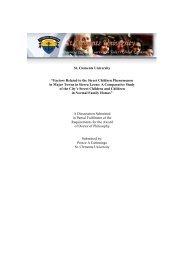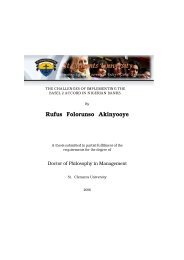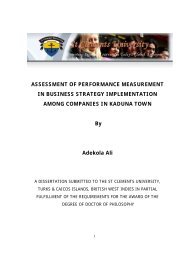The role of informal microfinance institutions in saving
The role of informal microfinance institutions in saving
The role of informal microfinance institutions in saving
You also want an ePaper? Increase the reach of your titles
YUMPU automatically turns print PDFs into web optimized ePapers that Google loves.
<strong>The</strong> cooperative formula was then conceived and became a solution to capitalist exploitation<br />
and <strong>in</strong> this sense; it became the sister <strong>of</strong> the labor union movement. <strong>The</strong> second generation <strong>of</strong><br />
the pioneers <strong>of</strong> modern cooperation emerged, not <strong>in</strong> cities, but <strong>in</strong> certa<strong>in</strong> European rural<br />
environments <strong>in</strong> the late 19 th century. In the 1860s,these pioneers <strong>in</strong>vented the formula <strong>of</strong><br />
agricultural cooperatives and sav<strong>in</strong>gs and credit cooperatives <strong>in</strong>spired by the success <strong>of</strong> the<br />
consumer cooperatives formula <strong>in</strong> Great Brita<strong>in</strong> and based on old traditions <strong>of</strong> rural solidarity-<br />
aimed to meet the foremost economic needs, that went unsatisfied as a result two th<strong>in</strong>gs<br />
happened:<br />
Agricultural cooperatives enabled families <strong>of</strong> farmers and livestock raisers to organize their<br />
own supply systems <strong>of</strong> agricultural <strong>in</strong>puts and market their products and to no longer<br />
depended on merchants and bus<strong>in</strong>essmen <strong>in</strong> the cities.<br />
.<strong>The</strong> SACCOs enabled them cease longer depend<strong>in</strong>g on moneylenders and to f<strong>in</strong>d the credit<br />
necessary to modernize their agricultural cooperatives. In Europe, <strong>in</strong> the late 19 th century,<br />
especially <strong>in</strong> Italy, there were peoples’ banks with none <strong>of</strong> the characteristics <strong>of</strong> the SACCOs<br />
named as mutual benefit societies or cooperative syndicates.<br />
Almost all <strong>of</strong> the <strong>in</strong>dustrialized countries <strong>of</strong> the North, especially the United States <strong>of</strong> America<br />
,used agricultural cooperatives(for sav<strong>in</strong>gs) that enabled rural families(farm<strong>in</strong>g and handicraft)<br />
to become <strong>in</strong>tegrated <strong>in</strong>to national and <strong>in</strong>ternational markets and constantly raised their<br />
liv<strong>in</strong>g-standards until they atta<strong>in</strong>ed a level comparable to that <strong>of</strong> the urban environment.<br />
In Europe <strong>of</strong> the 19 th century, the promoters, i.e. those at the orig<strong>in</strong> <strong>of</strong> the first cooperative<br />
experiences, were primarily part <strong>of</strong> a particular ideological current, which can be qualified<br />
generally as “Christian democratic socialism” and came from the new <strong>in</strong>dustrial, commercial<br />
and clerical bourgeoisie and petty bourgeoisie.<br />
<strong>The</strong> follow<strong>in</strong>g are the different SACCOs models <strong>in</strong> the European and American SACCOs<br />
models:<br />
Four models <strong>in</strong>fluenced the development <strong>of</strong> SACCOs throughout the world, each related to<br />
the founder <strong>of</strong> these types <strong>of</strong> sav<strong>in</strong>gs and credit organizations.<br />
43
















